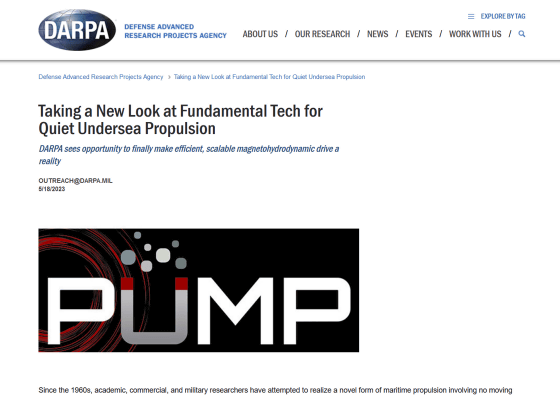DARPA announces a program for practical use of ``electromagnetic propulsion'' that moves ships using magnets and electric power without using moving parts

Mechanisms such as wheels and propellers are usually used for propulsion engines that move vehicles, and in the case of ships, screw propellers and jet injection structures are used. However,
Taking a New Look at Fundamental Tech for Quiet Undersea Propulsion
https://www.darpa.mil/news-events/-2023-05-18

DARPA's silent MHD magnetic drives for replacing naval propellers
https://www.naval-technology.com/features/darpa-silent-mhd-magnetic-drives-for-replacing-naval-propellers/
Electromagnetic propulsion is a method in which a Lorentz force is generated by an electric current and a magnetic field in a fluid in which an object exists, and the object is propelled by that force. In the case of a ship, it is possible to obtain propulsion by generating a vertical magnetic field in the water with an electromagnet and passing an electric current in the horizontal direction of the hull with electrodes provided on the hull.
The advantage of using electromagnetic propulsion instead of screw propellers, jet injection, etc. is that there are no moving parts, so noise and vibration can be greatly reduced. Therefore, it becomes difficult to detect the position of ships by sonar, and it is expected to improve the stealth performance of submarines and underwater drones. In addition, it seems that the position of the ship can be known by the system that detects magnetic anomalies due to the structure of electromagnetic propulsion that generates a large magnetic field.
Also, since electromagnetic propulsion can exert propulsive force on any force depending on the direction of the current or magnetic field, it may improve the maneuverability of the ship.

In the 1960s, electromagnetic propulsion began to be researched as a technology to replace propellers and drive shafts, and in 1992, the experimental ship
This is an impressive example in the history of electromagnetic propulsion, but the propulsion mechanism alone occupies most of the 30m hull of the Yamato 1, and the capacity was limited to 10 people, including the crew. There was also a problem that it took more than 10 days to complete. After all, it is much cheaper and more efficient to propel with a diesel engine and propeller, and after that there are no practical development plans except for military purposes.

by wikimedia commons
In recent years, however, there has been significant progress in the development of electromagnets using rare earth barium cuprate (ReBCO) , which exhibits high-temperature superconductivity, with magnetic fields of up to 20 Tesla , exceeding the approximately 4 Tesla used during the Yamato 1 voyage. The ability to generate large magnetic fields has been demonstrated. With this technological innovation, there is a possibility that 90% efficiency can be realized in electromagnetic propulsion.
Therefore, DARPA announced that it will implement a 42-month long-term program 'Submarine Magnetic Fluid Pump (PUMP) Program' to develop military-grade electromagnetic propulsion. “Now that the glass ceiling has been broken in high magnetic field generation, PUMP is aiming for breakthroughs to solve electrode materials challenges,” said Susan Sweizenbank, PUMP program manager at DARPA. increase.
The electrode material issue addressed by DARPA is the formation of air bubbles on the electrode surface of electromagnetic propulsion systems in seawater, which can lead to reduced efficiency and deterioration of the electrode. The PUMP program will investigate ways to mitigate the effects of hydrolysis and erosion, and develop models and tools for scaling electromagnetic propulsion systems, including hydrodynamic, electrochemical, and magnetic. They will also develop a promising electrode material system and prototype an electromagnetic propulsion system that can be scaled up.
DARPA plans to make a detailed announcement on the PUMP program in late May or early June 2023.
Related Posts:







